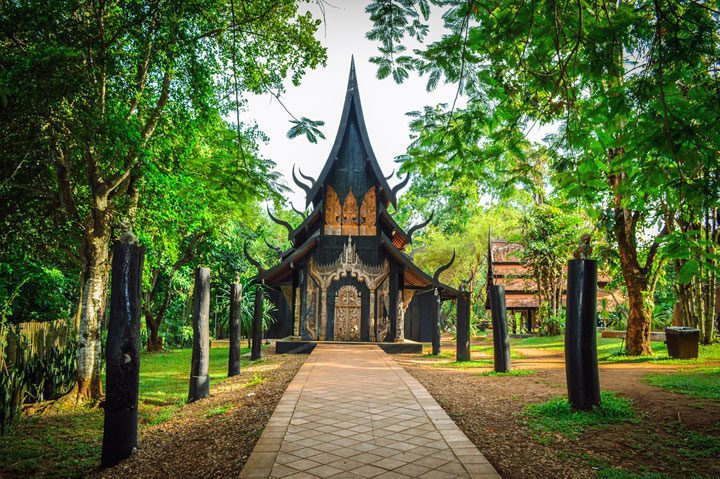Ban Dam Museum in Chiang Rai

Photos593 / Shutterstock.com
In 2014, the well-known Thai artist Thawan Duchanee passed away at the age of 74. Maybe that doesn't mean anything to you, but as the photo of a striking old man with a large white beard, you may look familiar. Thawan came from Chiang Rai and it is therefore not surprising that there is a museum in Chiang Rai dedicated to this Thai artist, who is also famous beyond the country's borders.
The museum, called Baandam (meaning 'black house') is not 1 building but a collection of 40 larger and smaller houses in all shapes and built of all kinds of materials (wood, glass, stone, terracotta). These houses contain a large number of his works, namely paintings, sculptures, animal bones and skins, horns, silver, gold and various other objects of art. Thawan worked on this museum until his death. It is located in Nang-Lae, in Chiang Rai, his birthplace.

Valoga / Shutterstock.com
Thawan not only studied in Thailand (he was a student in the first class of the Art Faculty of Silpakorn University, under the guidance of the Italian professor Silpa Bhilasri), but he also studied at the Academy of Fine Arts in Amsterdam in the 60s.
In more than 50 years of artistry, Thawan has built up an extensive collection with its own, recognizable style. He made Thai art known worldwide. Many of his works can be seen in modern art museums in Europe, Asia and North America. His style is a mixture of Buddhist symbolism and spirituality with a contemporary twist, characterized by a lot of energy (much of his work is in black and white).
His work was not appreciated by everyone. It would be blasphemous. He also prided himself on earning a lot of money with his work, which is not generally the case for artists.
For more information: www.thawan-duchanee.com


I always look for meaning of Thai names, very nice. Thawan Duchanee (นายถวัลย์ ดัชนี pronounced: thàwǎn dàchánie:) Thawan means 'mighty, great, great' or as a verb 'to command, rule, rule' and Duchanee means 'index finger', all from Sanskrit. Beautiful name for such a versatile artist!
yes, a true artist, first thought this was a temple, many chinese tourists, and beautiful wood-carved chairs, with many horns, long snakes on the table, crocodiles, felled of course, and artful buildings on the grounds, some guns, which my wife also had her father, and many more beautiful sights, by the way, there is also a university town nearby, also nice to take a look, close to Chiangrai airport, yes there is a lot to see in the north, especially go and see
That University is Mae Fah Luang University. Indeed a large campus in a park-like landscape. Apart from the faculty buildings, there is little to see except for the center for Chinese language, which was established with a donation of 60 million Baht from the Chinese government. You really feel like you are in China there…..
At the beginning of his art education, Tawan was terribly trampled on his soul because a teacher only called him a copyist.
He then decided to go his own way and with success.
Two of his works can be seen in the new museum in Pattaya.
we were good friends
based on the fact that he could speak Dutch with me
and he mastered that language well
as a Dutchman living in chiangrai since 2001 and visual artist
our conversations were not exclusively about Art
he was versatile creative and a striking personality
with a great sense of humour
I appreciate this contribution.
Instead of the sweet confectionery style of Khun Kositpiphat with his “white temple”, the enamel of which spontaneously jumps off your teeth when you look at it, it is a relief to see Thawan's earthy approach. I find it remarkable that travel organizations are mainly focused on the baroque white. Despite this, both artists regularly worked together during their lives.
Given Chris de Boer's academic status, I find his article rather careless.
The name of the Italian professor Silpa Bhilasri (correct: Silpa Bhirasri) is actually Carlo Ferocce, who came to Thailand between World War I and II, took a Thai name and wife and became an inspiration to many young Thai artists.
The “Academy for Visual Arts” is in fact the “Rijksakademie van Beeldende Kunsten”. Also the remark that Thawan's work would be “blasphemous” is only actually expressed by a limited number of “students” (ie in training, not as professional academics) during an exhibition by Thawan and can therefore not be regarded as a general (Thai) feeling represented, .
During Thawan's stay in the Netherlands, my wife became friends with Thawan as a young girl. We first visited him in 1974 in his BR Apartment in New Petchburi Rd in Bkk. Afterwards in his studio in Navatanee (Bkk) and his studio on the family compound in Chiang Rai and of course after 1980 in Baan Dam. We have regularly stayed in Nang Lae on Baan Dam for several nights over the years. I remember stepping on a tiger claw at night during one of our stays at Baan Dam. I was immediately wide awake. But I survived.
During our stay in Chiang Rai, Thawan provided us with a car and driver on every visit. In this way we have visited Chiang Saen, the Golden Triangle, Santikhiri (formerly Mae Salong) and Ban Therd Thai (formerly Bin Hin Taek, headquarters of Shan warlord and drug lord Khun Sa) several times. In 1982 I witnessed the advance of the Thai army against Khun Sa: helicopters, trucks with men and two cars with .50 caliber machine guns. Those were the days.
Thawan built his studio on the family property in Chiang Rai in a few days after his return to Thailand in 1968 with a number of craftsmen. Cost: 3.0000 baht. Nevertheless, in April 1968 he already had an exhibition in Gallery 20 (above Chalermnit bookstore owned by ML Manich Jumsai, descendant of Prince Prisdang) around the corner from Hotel Erawan in Bangkok.
Afterwards he had a similar studio built for his son Mongdoy (later Doytibet). He personally showed us this home, with a brand new Harley Davidson motorcycle in the front room. Afterwards I learned that Mongdoy had had a serious accident with this motorcycle. A great opportunity for Tino Kruis to explain the aforementioned names,
I saw in November 2018 that his studio had meanwhile been demolished. His son's studio looked very deserted. Maybe as a Thai socialite too often in Bangkok.
Thawan said in 1980 that he had bought a piece of land not far from Chiang Rai to place a number of objects on it. In fact, this is the origin of Baan Dam. Gradually, this project has grown into the current complex, initially in natural color, later everything in black. We have stayed there several times over the years.
In November 2018, at the invitation of Prof. Prawit Mahasarinand of the Bangkok Art and Culture Center (BACC) in Bangkok gave a lecture on the “Dutch period” of Thawan. During my stay in Thailand I visited various museums, galleries and libraries for my research into this period.
Of course I also visited Baan Dam in 2018. Where in 2006 I could only reach Baan Dam via a dirt road through pineapple fields. there was now a two-lane asphalt road leading to a vast parking lot with enough space to park a column of buses.
Now we just have to wait and see when the current incompetent regime is able to grant the falang unfettered access to their country.